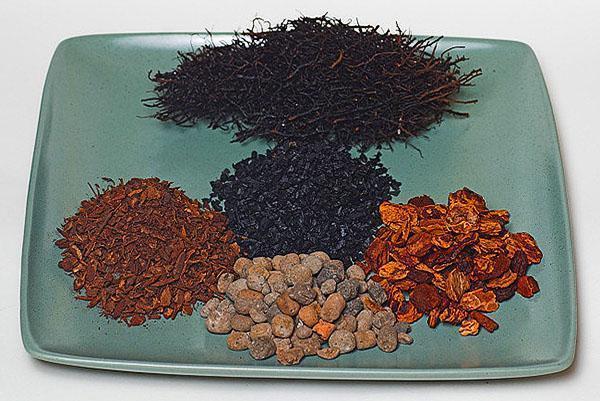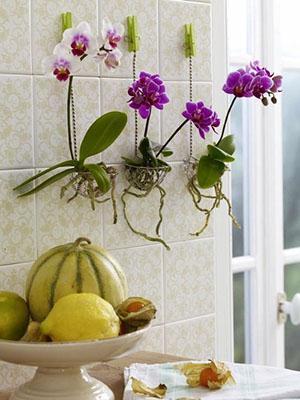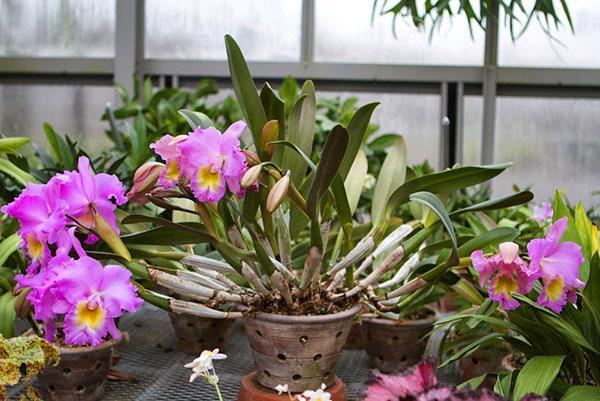Components of soil for orchids and features of their choice

The regal orchid requires truly royal attention, but it is important not to overdo it in caring for the plant. The first specimens, delivered to Europe from the far corners of America and Asia, died en masse, and the reason for this was the incorrectly selected soil for orchids. Trying to please gentle beauties, gardeners planted plants in the best, richest humus substrate, but powerful roots did not grow, but died off.

Substrate for orchids of tropical origin is needed mostly so that the flower can gain a foothold and hold in a certain place. When selecting components, they pay attention not to nutritional properties, but to how structured the finished soil is and how permeable to air and moisture.
Orchid soil usually contains several components, and more and more ingredients are used not only of natural origin, but also of man-made origin. It is only important that the selected substrate for orchids does not create conditions for root decay, provides air access to them, and for certain species and light.
The latter condition applies to plants whose roots are involved in the process of photosynthesis. An example is the phalaenopsis orchid, which is popular with flower growers, the soil for which is mixed from tree bark, small pebbles or expanded clay, moss, fallen leaves and pieces of birch coal.
Orchid bark
 The main component of ready-made and homemade orchid substrates is tree bark. The material can be purchased at flower shops or you can lie with your own hands. Russian flower growers prefer pine bark, but if it is not possible to find it nearby, any conifers, oak, beech and other trees will do.
The main component of ready-made and homemade orchid substrates is tree bark. The material can be purchased at flower shops or you can lie with your own hands. Russian flower growers prefer pine bark, but if it is not possible to find it nearby, any conifers, oak, beech and other trees will do.
The bark for orchids is collected from cut logs or dead wood. In this case, she:
- easily falls behind and lends itself to processing;
- has less acidity than fresh;
- does not contain as many resinous substances as on living trees.
When collecting, attention is paid to the quality of the material. It is better to take strong pieces of bark without signs of mold, rotting or massive insect damage. In the composition of the substrate for orchids, the bark is under significant stress due to the effects of moisture and the growing root system. Initially rotten, old pieces will quickly decay, and the flower will soon need a transplant.
Like any natural material, bark is a potential hazard to a houseplant. It can contain dangerous insects, bacteria and fungi.
Therefore, before sending to the flower pot, the collected pieces of bark for the orchid:
- cleaned from softened fabrics, wood and resin;
- subjected to heat treatment in an oven, steam or digestion methods;
- dry thoroughly.
 Coniferous, and especially pine bark for orchids increases the acidity of the soil, so it is useful to add a little dolomite flour to the mixture to neutralize it.The size of the fragments is selected depending on the type of plant being grown. The smaller the fraction, the:
Coniferous, and especially pine bark for orchids increases the acidity of the soil, so it is useful to add a little dolomite flour to the mixture to neutralize it.The size of the fragments is selected depending on the type of plant being grown. The smaller the fraction, the:
- denser soil;
- less air penetrates into its thickness;
- better moisture retention.
Before mixing the substrate, the bark is immersed in warm water for a couple of hours so that it is saturated with moisture, and the plant immediately falls into an environment favorable for growth.
Sphagnum moss for orchids
 Sphagnum marsh moss, widespread in Russia and other countries, is appreciated by flower growers for its ability to:
Sphagnum marsh moss, widespread in Russia and other countries, is appreciated by flower growers for its ability to:
- give the soil looseness;
- retain water without compacting orchid soil;
- absorb excess salts harmful to plants from irrigation water;
- have a bactericidal effect.
Specialized stores offer ready-made, already disinfected and dried sphagnum for orchids, but if you wish, you can prepare the moss yourself. And after collection, be sure to rinse, sort out, soak in boiling water, and then squeeze and dry well. The best time to harvest is before winter.
Some growers prefer to use live sphagnum or other moss, but here it is worth remembering the risk of dispersal of insects and microorganisms, which in many cases remain in natural material.
Moss is included in the soil for orchids, and is also used:
- as a mulch layer;
- as an independent substrate for the rooting of daughter outlets;
- for compacting plants on blocks and in baskets.
Sphagnum is irreplaceable for orchids that require resuscitation due to rotting or drying out of the root system.
Other components of orchid substrate
Small expanded clay used for drainage becomes an indispensable assistant to the florist who grows epiphytic orchids. This material is highly hygroscopic and perfectly structured the soil.
 Charcoal has similar properties, which also has a disinfecting, absorbing effect. The composition of the soil for orchids includes pieces of coal at least two centimeters in size. If the fraction is finer, the coal quickly collapses and, turning into dust, settles on the roots, interfering with the nutrition of the orchid, and compacts the substrate.
Charcoal has similar properties, which also has a disinfecting, absorbing effect. The composition of the soil for orchids includes pieces of coal at least two centimeters in size. If the fraction is finer, the coal quickly collapses and, turning into dust, settles on the roots, interfering with the nutrition of the orchid, and compacts the substrate.
Polyfoam and foam rubber cannot be called traditional soil components for cultivated plants. However, they have already proved their usefulness in growing such a capricious crop as orchids. Fragments of synthetic materials in the substrate for orchids are durable, do not accumulate or exude harmful substances into the soil, and provide high friability and air permeability.
 In pots of adult large plants, you can add high-moor peat. The advantages of this component can be considered the ability to retain moisture, high permeability to air and unattractiveness to harmful insects and microflora. The material has only one drawback - high acidity.
In pots of adult large plants, you can add high-moor peat. The advantages of this component can be considered the ability to retain moisture, high permeability to air and unattractiveness to harmful insects and microflora. The material has only one drawback - high acidity.
The task of loosening the substrate for the orchid does a good job:
- steamed and dried nutshells;
- coconut fiber;
- fallen leaves;
- perlite and vermiculite.
 Bottle corks made of natural bark are used as an exotic, but quite workable filler.
Bottle corks made of natural bark are used as an exotic, but quite workable filler.
When choosing the composition of the soil for orchids, the florist must remember that the longevity of the substrate depends on the resistance of the components and on the size of individual pieces of bark, coal, foam or expanded clay pellets.
If a plant living on the ground appears in the home collection, then the soil for the orchid is selected more nutritious and dense. You can take ready-made orchid soil and mix it with garden soil, a little humus, sand and perlite.